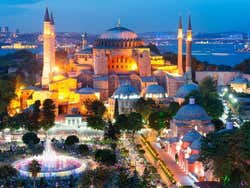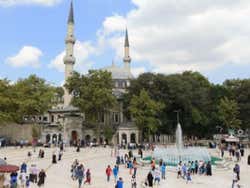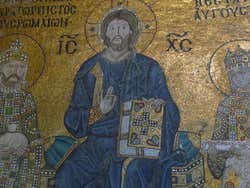
Hagia Sophia
The Hagia Sophia or Ayasofya as the Turks call it, is the symbol of Istanbul. It was built during the reign of Justinian between 532 and 537 and is a masterwork of Byzantine art.
Between 1204 and 1261, the Hagia Sophia was the church of the Pope. In 1453 it was captured by the Ottoman Empire and converted into a mosque. The Ottomans added four minarets to the church, as well as a theological school and a public dining room
In 1935, Atatürk transformed the temple into a museum.
Exterior
Found in Istanbul's highest point the Hagia Sophia dominates the Istanbul skyline. Its four minarets and 30-metre wide dome are the most enduring and most representative images of the Turkish metropolis.
Interior
The interior is stunning. The dimensions of the main hall (70x74 metres), the natural illumination, the enormous decorative medallions and the monolithic columns have left millions of visitors agasp over the years.
In the second floor of the basilica houses different mosaics of great historical interest, with the star of the show being the mosaic of Emperor Constantine and Empress Zoe adoring Christ.
As well as the mosaics, you can also find the tomb of Enrico Dandolo, Doge of Venice on the second floor, after his death in Constantinople in 1205.
Advice
Aside from trying to get there as soon as possible (long lines form at the entrance), don't miss the views of the Blue Mosque from the windows on the second floor.



Schedule
Summer (1 April - 1 October): 09:00 to 19:30.
Winter (1 October - 1 April): 09:00 to 19:00.
Transport
Tram: Sultanahmet, line T1.
Nearby places
Basilica Cistern (176 m) Archaeological Museum (363 m) Blue Mosque (443 m) Museum of Turkish and Islamic Art (502 m) Gülhane Park (569 m)
